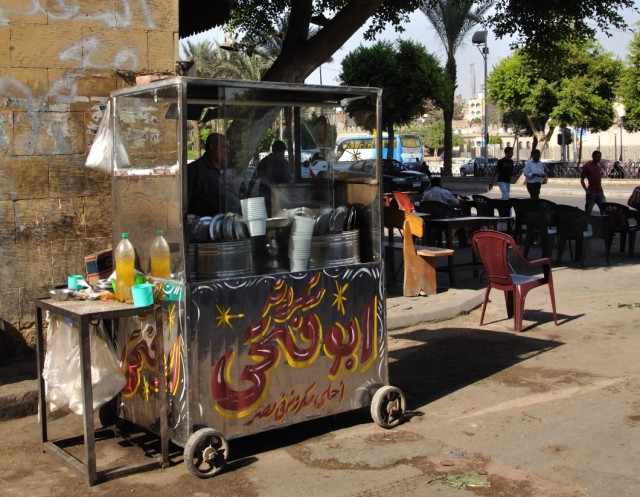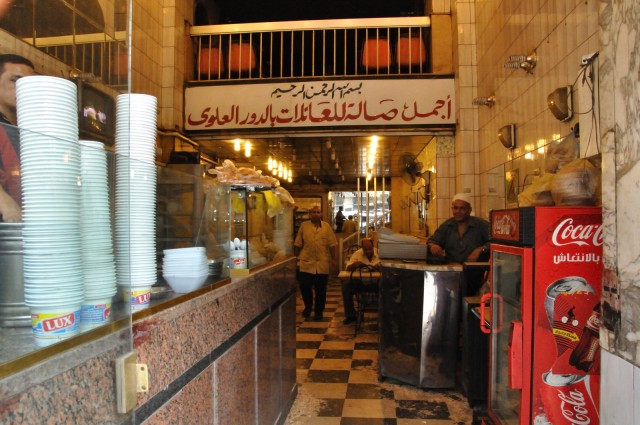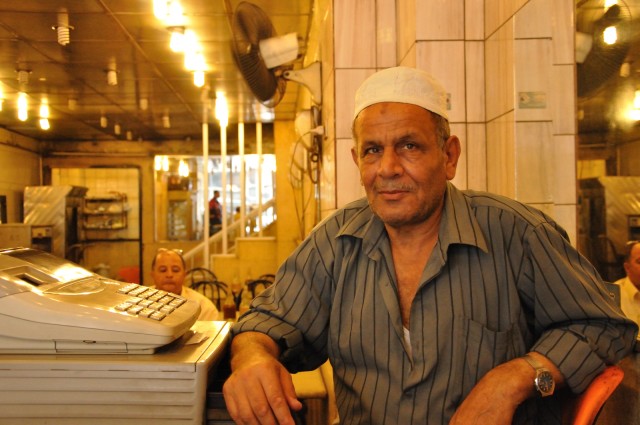20 million souls hustling and crowding, thronging grand avenues and shady alleys, buying and selling in slick modern shopping centers and ancient covered markets, honking and shouting, cutting business deals by cell phone and hauling furniture in donkey carts… Cairo is a busy place. To keep this massive and voracious population going, the city boasts a spectacular array of street food.

In working class neighborhoods, like here in Old Cairo, it is common to see kushari sold from carts wheeling through the streets and alleys.
Without a doubt, the queen of Cairo street foods is kushari, a steaming bowl of rice, lentils, garbanzos and a mish-mash of diverse shapes of pasta, sprinkled with crispy fried onions, doused with a spicy tomato sauce and eaten at any time of day or night for about 30 cents a pop.

Gleaming aluminum bowls wait for “eat in” clients, who eat standing up beside the cart or seated at the café on the corner; plastic ones stand ready for take out.
Fast, cheap, and nourishing, it was clearly born as a staple for the working urban masses. But so intensely addictive are its charms that as night falls in downtown Cairo one is likely to find well heeled businessmen and packs of trendy adolescents as well as taxi drivers and construction workers all eagerly wolfing down their kushari under glaring flourescent lights.

Downtown kushari establishments run more overhead. Lux is an chain with locations all over the city; this one is on the busy Qasr al Aini Street, surrounded by government buildings.

While Lux was once the cutting edge in kushari service, it has been outdone by snazzier new places like Abu Tarek. The kushari is still great, and I confess a preference for Lux's sawdust floors over Abu Tarek's aquarium-and-fountain bonanza.
Where does kushari come from? Political theorist and food enthusiast Sami Zubaida makes the interesting proposal that Cairo’s kushari is derived from the similar Indian kitchri, brought by British troupes to Egypt in the beginning of the 20th century. As Zubaida points out, the globalization of fast food goes back to way before Mr.Kroc fashioned the golden arches, and has often followed unsuspected routes.

First, you order at the cash register: kushari in the 20 cent, 30 cent or 40 cent sizes, take out or eat in. The management is extremely gracious.

The server stands ready at his great aluminum vats: one contains rice, one pasta, one garbanzos and one lentils. These are scooped one by one (in that order) into your bowl. The kitchen assistant then deftly scatters fried onions on top.
If initially the food itself followed British colonial efforts from India to Egypt, the more recent American empire has made its influence felt in how it is served. Instead of disappearing before the onslaught of hamburgers and fried chicken, local street foods are updating their image and presentation, and competing with international fast food on its own terms. While in the older neighborhoods kushari is still ladled out from wooden street carts and in tiny hole-in-the-wall eateries, in the swankier parts of town you can get your fix at a gleaming new kushari restaurant franchise with formica banquette seating and waiters in uniforms with baseball caps.

The bowl is served with a small dish of tomato sauce perched on top, which you pour over the kushari just before eating so the onions stay crisp. Spicy sauce and garlicky vinegar are provided on the table, to add at will. So simple, so magnificent.
Of course in Egypt fast food – even fast food as humble as kushari – is for the relatively well-off, those who have cash salaries like the legions of civil servants which largely comprise Cairo’s urban middle class. For a majority of the population which lives on under 2 dollars a day, the bright lights and glamour of a kushari restaurant belong to another world.
